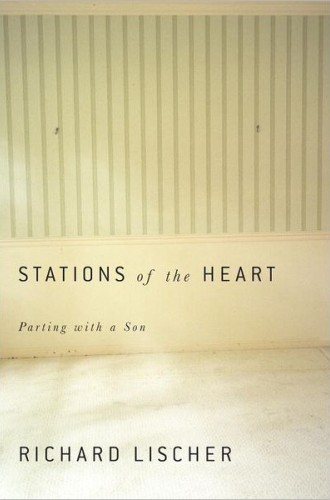Cross-shaped story
On April 13, 2005, Richard Lischer’s 33-year-old son, Adam, phoned his dad with the results of his latest medical checkup. His cancer, first diagnosed 16 months previously, was back. It had spread throughout his body.
When Lischer received the call he was in the ER with his father-in-law, who had just had a heart attack. Lischer’s wife, Tracy, was in another part of the hospital with her mother, who was being treated for uterine cancer. From their separate stations they ran to their son’s side, arriving in time to hear the oncologist say: “Metastatic melanoma typically does not respond well to radiation or chemotherapy.”
In just 95 days, Adam Lischer was dead.
“A father has no business writing a book about his son’s death,” Lischer writes in the first chapter of Stations of the Heart.
A parent is not designed to comprehend the child’s life in its entirety, any more than the child is meant to experience the parent’s early days or youthful indiscretions. It is a sensible arrangement. Children are not permitted to witness the passions that produced them, and parents are not allowed to observe their final hours.
Read our latest issue or browse back issues.
And yet some parents, like Lischer, must watch their children die, and some will write memoirs. Few such memoirs will be published, and fewer still will be read. The death of a child is every parent’s worst fear. Even our language makes it difficult to talk about: we can speak of widows and orphans but have no word for people who have lost a child.
A few exceptional memoirs nevertheless manage to break through our dread and compel our attention. Two notable ones are John Gunther’s inspirational Death Be Not Proud (1949) and Nicholas Wolterstorff’s anguished Lament for a Son (1987), both still in print. Stations of the Heart deserves a place alongside these classics for many reasons. It is elegant without excess, personal without self-absorption, profoundly emotional without sentimentality. It tells as much about the father as about the son, exploring the complicated relationship between them. It looks beyond the one man’s death to the death we all will face. It raises religious and philosophical questions without offering pat answers.
The story is simple. In late 2003 a melanoma is removed from Adam’s back. It’s at stage two, the doctor says: a deep lesion, “angry cells,” but no lymphatic activity. They have gotten it all, and Adam has a 70 percent probability of remaining cancer free. Every three months he will be checked.
After the brief scare, life returns to normal. Adam joins his mother’s law firm in Durham, North Carolina. He and his wife, Jenny, buy a house, plant trees and conceive a child. And then the cancer returns, this time at stage four. There is only a 15 percent chance that it will even respond to treatment, the doctor says. Long-term survival is out of the question. Jenny is nearly six months pregnant.
Adam, his wife and his parents start seeing doctors: dermatologists, surgeons, radiologists, hematologists, oncologists. Four rounds of chemo and radiation all prove ineffective. Other treatments are impossible because of the lesions that have formed in Adam’s brain. He has seizures; he returns to the hospital. Jenny is eight and a half months pregnant.
You know what’s going to happen.
What sets this memoir apart from others is neither its anecdotal remembrance of Adam’s life nor the bare outline of his dying, but rather its exploration of meaning and wholeness in the midst of suffering. Richard Lischer is a Lutheran minister, a systematic theologian and a professor of preaching at Duke Divinity School. His book’s title refers to the stations of the cross, a series of paintings or carvings of Christ’s final hours usually displayed in the naves of Catholic churches. The stations in the abbey church at St. John’s University in Minnesota are unusual, Lischer writes: they are “nothing more than plain crosses cut into the granite pavement. . . . When you stand or kneel on one of these cross-shaped slits, . . . they remind you that anyone’s pain, including your own, can find a place in something larger than itself.”
Adam’s pain found its place in a community of love, hope and faith. One of his first acts after the dire diagnosis was to be confirmed in his wife’s Catholic parish so he and Jenny could receive communion together. Together, every day
they lit candles, said their prayers, recited the psalms, went to daily Mass, did the Stations, knelt at icons, watched old movies, ate pizza, and looked at the stars from their deck, all according to a new standard of time that wasn’t really time at all, but a heightened awareness of the interlocking spaces through which he had to move to reach his goal.
At Adam’s request, his parents joined the young couple “for every treatment, inoculation, consultation, and scan.” “Team Adam,” they called themselves, and they clung to hope against all hope. “It wasn’t that I believed Adam would be cured,” Lischer writes, “but in defiance of all the evidence I was positive he would survive, our family would remain whole, and we would bless the Lord.”
Friends, colleagues and even strangers began delivering prepared food to the Lischer households. “The cancer dance . . . would have been unendurable,” he writes, “were it not for the table and the common meal, where we could laugh, pray, relax, and be our true selves.”
But the relentless rogue cells continued to spread, more rapidly than even the pessimistic doctor had anticipated. Adam’s via dolorosa, his stations of the cross, came to an end just three months after diagnosis. And then came grief—“a series of caves—dark, multiple, and unfathomed. You do not explore them. You fall into them.” Clichés such as “moving on,” “turning the page” or “closure” were worse than useless; chaos and darkness are prerequisites for creation. Healing takes time.
A novel, wrote Azar Nafisi in Reading Lolita in Tehran, “is the sensual experience of another world. If you don’t enter that world, hold your breath with the characters and become involved in their destiny, you won’t be able to empathize, and empathy is at the heart of the novel. This is how you read a novel: you inhale the experience.” She could have been writing about memoir.
The death of a child is an experience no one wants to inhale. And yet, as Lischer points out, we are, all of us, children of dust; “we are all creatures of the gap, living out our days between the giddy promises of youth and the inevitability of death.” As Adam’s health deteriorated, Lischer found it harder and harder to pray. But bolstered by those who shared his experience and involved themselves in his destiny, he hung on to this hope: that God will remember Adam Lischer, and all the rest of us too, because God loves.
Less than two weeks after Adam died, his daughter was born. “His departure and her arrival were marked by fearful pangs and cries and a leap into the unknown,” Lischer writes. “Who would have thought anything resembling joy could follow our night of weeping?”






